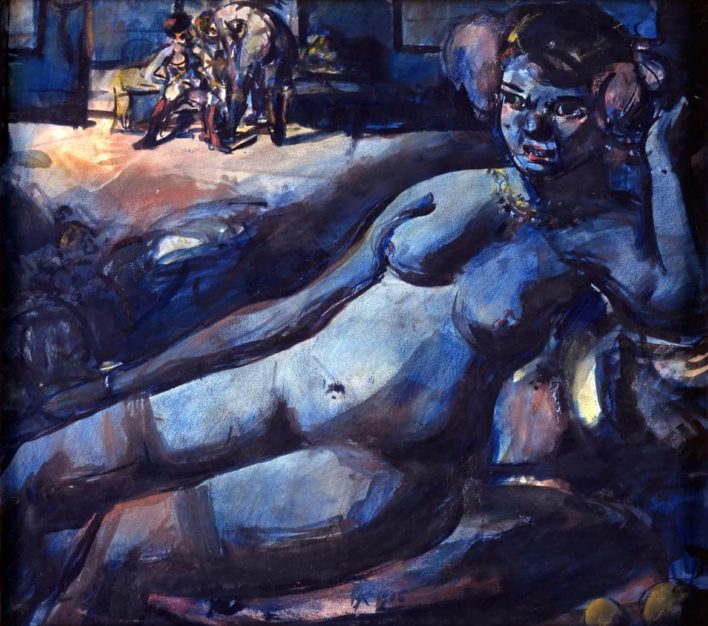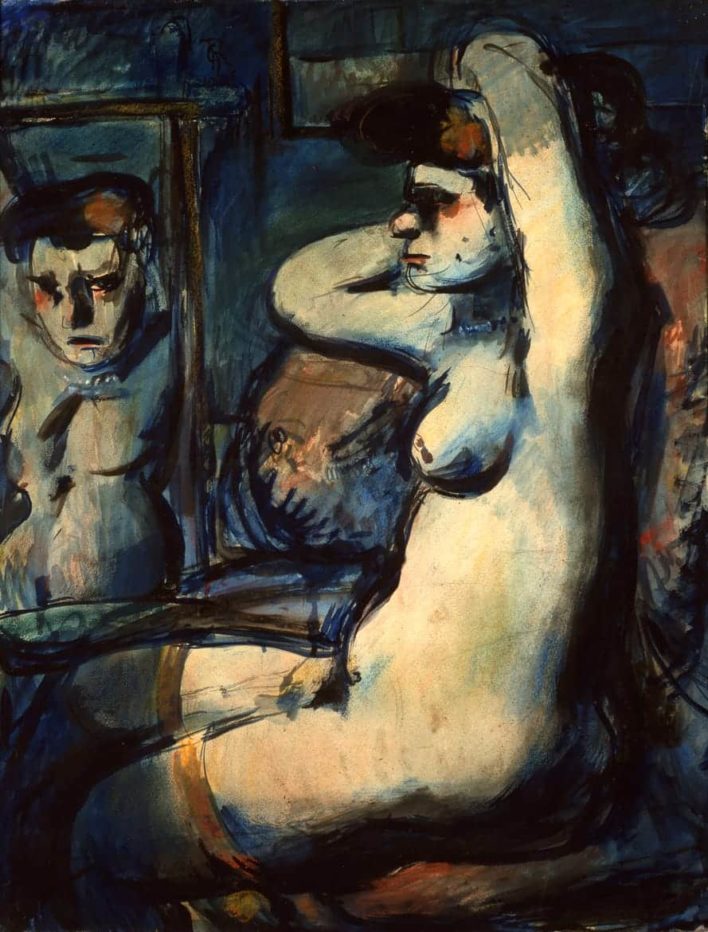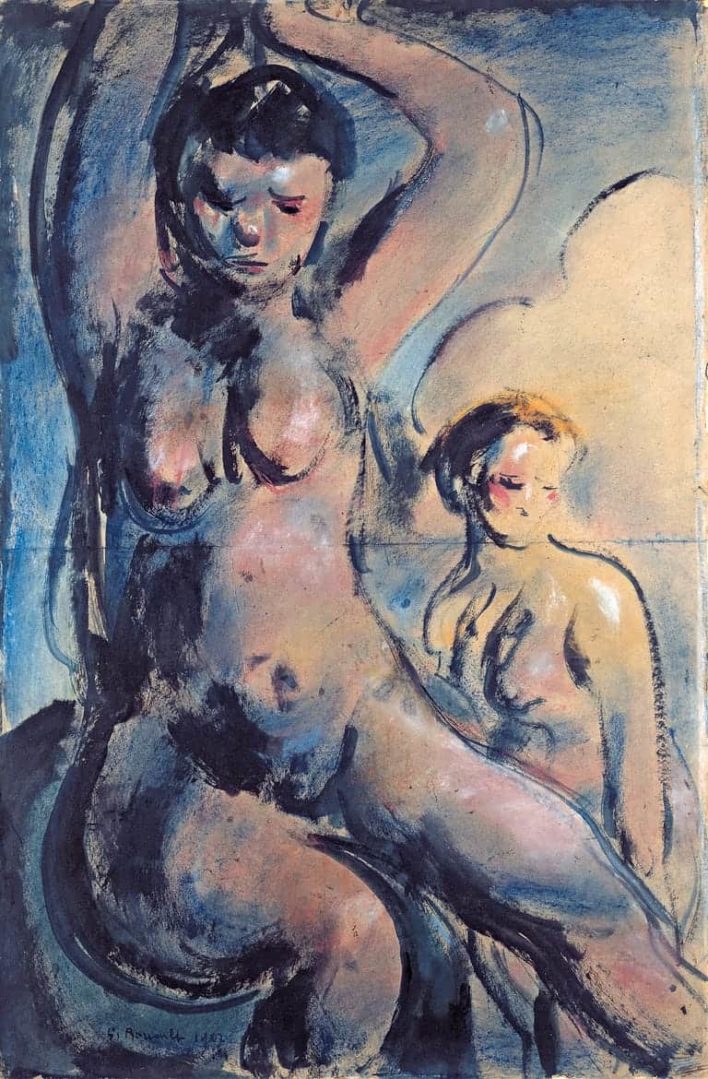1902-1914 | Rebellion
Deeply affected by his recent hardships, the death of Gustave Moreau and his solitude and sorrow, Rouault was “morally and physically exhausted”. Weak and exhausted, in 1902 he went to Evian for a period of convalescence. The peace and quiet and the beauty of the late autumn renewed his vision. He began paining with a new vigor.
During this period he forged new lifelong friendships with Léon Bloy and the philosophers Jacques and Raïssa Maritain. Inspired by Bloy’s ideas on society, Rouault reflected these in his painting (”Les Poulot”, characters from La femme pauvre [The Woman Who Was Poor] by Bloy). The Maritains would remain loyal supporters of Rouault’s work. Despite the unwavering friendship between Rouault and Bloy, Bloy rejected his paintings and never understood them.
“I underwent a moral crisis of the most violent sort. I experienced things which cannot be expressed by words. And I began to paint with an outrageous lyricism which disconcerted everybody.
Georges Rouault quoted by Georges Charensol


Prostitutes, clowns and judges
The inner turmoil of this past crisis was reflected in a new artistic expression. From his brush were born figures with caricature-like faces in a grotesque portrayal of the disreputable aspects of society. He often distorted the faces of prostitutes, clowns and judges, literally “scarring” them with his brush strokes. Rouault created characters, allegories of lust, misery, vice and complacency. He was interested in seeing the person underneath the mask, in revealing their bare truth.
The prostitutes who served as models at the studio close to Place Clichy became the “Filles” (prostitutes) in his paintings from 1902. Perhaps Rouault contemplated the words of Jesus “I tell you the truth, tax collectors and prostitutes will get into the Kingdom of God before you do”?
The painter shocked audiences. The public were alarmed by the blackness of his works, in contrast with the brightness of the impressionists. They became known as the “tableaux noirs” (black paintings). The critic Vauxcelles defended the artist:
When he paints a joyful female, Rouault does not cruelly enjoy, unlike Lautrec, the vice that her body exhales, he suffers and weeps for it.
Circus performers appeared in the works of Rouault in 1903. The circus is one of the painter’s most recurrent themes. The Cirque Médrano near his studio brought back memories of his childhood in Belleville.
I saw quite clearly that the ‘Clown’ was me, was us… This rich and glittering costume, it is given to us by life itself…I have the defect…of leaving no one his ‘glittering costume’ be he king or emperor. I want to see the soul of the man in front of me…
Letter to André Schuré, 1904
Rouault then attended court sessions at the Palais de Justice in Paris, invited by Deputy Prosecutor Granier whom he had met in 1908. “More than the inequality between Rich and Poor, what outrages him more in our society is the parody of justice.” “Rouault is only a witness to the terrible tragedies played out by sinners, who are themselves examples of human misery” (Bernard Dorival).
The reason I gave my judges such woeful faces was doubtless because I expressed the anguish that I myself feel when I see one human obliged to judge another. If ever I mistook the judge’s face for that of the defendant, I was merely betraying my own distress…The judges themselves I cannot condemn.
These themes were inspired by an observed reality but filtered by his inner vision and his impulsive and passionate character. Rouault did not intend to distract and did not seek to depict beautiful or attractive images. He imbued his work with a moral and human experience.

Rouault affirms his individuality
At the beginning of the 20th century, Rouault affirmed and explored his individuality. A new style emerges. The paintings of this period were characterised by the violence of drawing and colour, the ferocity of the line and sharp and insistent strokes. Distorting the faces of his figures allowed him to emphasise his expression. He abandoned his old style at the risk of losing the support of the collectors of Gustave Moreau. The brutality of his work shocked his contemporaries. Despite the letters he received heavily criticising his work, he persisted with his new style.
In this period, Rouault experimented extensively with different paint mediums. He mixed watercolours with gouache and pastels on paper which he then glued to the canvas. He obtained a unique texture and a subtle harmony of colours. Around 1910, he started to use oil paints which offered a richer palette of colours. Progressively, his use of oils replaced these mixed techniques. Rouault explored different techniques in search of the one that would best suit his personality. He experimented heavily with ceramic art and then printmaking. Through working with these two mediums he discovered a need for a craftsman-like approach, which, after years of experimentation, would serve to enrich his paintings.
The years 1913 and 1914 marked the beginning of a new phase in his artistic development. New themes emerged and there was an increasing emphasis on a meditated balance of forms. After much experimentation and hard work, Rouault gradually found and perfected his techniques of expression. His paintings masterfully combined the skill of a craftsman and the heart and soul of an artist.
